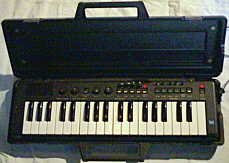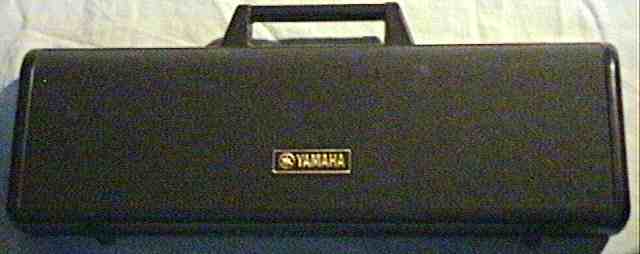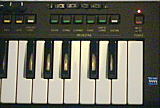 |

This is the instrument in its carry case. |
| YAMAHA PS-2 | analogue keyboard with accompaniment & carry case |
This brown, ultra- compact keyboard from 1980 was one of the very first polyphonic portables with automatic accompaniment; it constitutes (together with Yamaha PS-1 and PS-3) the beginning of the famous Yamaha PortaSound series and came in a brown hard shell plastic carry case.
 |

This is the instrument in its carry case. |
 |

Above the buttons you see the sound knobs and switches I added. The blue thing to the right is the DIP switch block. |
The analogue percussion sound quite dull, but at least it has an unusual timbre. The base is just a dull and quiet "pop" noise (like heard in the speaker when switching a radio on) consisting of 2 pulses muffled by a capacitor. The 2 tuned drums (tablas?, or congas??) have a strange timbre between drumming on empty plastic bottles and ceramic jugs. The semi- digital hihat was likely an innovation at its time and indeed sounds a bit more metallic than the analogue transistor noise ones found on other electronic percussion of that era.
When I bought my Yamaha PS-2 on a flea market, it made always
a static beeping of varying intensity in the speaker. It turned out that
a bad solder joint of an electrolytic capacitor at the voltage regulator
had caused this. After fixing it the beep was gone.
circuit bending detailsThe following descriptions relate to the instrument opened and placed keys facing down with view at PCB solder side.The CPU itself can outputs only 5 basic sounds made from a squarewave with volume envelope. They are a wind instrument sound (plain squarewave with short attack and release envelope, in 3 variants with different tremolo), a harpsichord sound (unequal pulse wave with ratio 1:7 and falling decay envelope) and a vibraphone sound (plain squarewave with falling decay envelope, integrated vibrato and sustain), those are post- processed by 4 switchable analogue filters to form all the final preset timbres. Apparently not all timbres are entirely squarewave, because in one of the filter settings(?) IC3 converts square waves into a coarse digital sawtooth wave (2 bit resolution?) that looks like stairs. For the envelopes of the 8 main voice channels there is a row of 8 capacitors near the CPU. The keyboard matrix has 2 cable connectors. Connector "C1" contains 6 output lines labelled N7..N2. Connector "C2" contains 7 input lines labelled {B11, B12, B21, B22, B31, B32, B41}. The inputs react on + 9V. Not all functions are controlled by matrix lines; e.g. the single finger chord(?) is enabled by pulling CPU pin 46 against +9V. additional keysAt CPU pin 38 there is an unused input where you can connect 6 higher note keys (wired through diodes against "C1").timbre synthesizer & distortionOriginally each sound preset switch selects one of only 3 squarewave basic sounds (different pulse widths and envelopes) and by another contact one of 4 analogue filters to set its timbre. The sound preset switches are wired in series in a way that when multiple buttons are pressed, only the rightmost one will take effect because additional opener contacts in each switch disconnect all switches left from it.filter controls: Each switch has 6 pins. At the leftmost switch "PS7OR" (organ) the 2 top pins are unused. For manual filter controls, connect the left upper pin of switch "PS7OR" with 4x parallel [a 100 kOhm trimmer in series with a 10 kOhm potentiometer (wired as variable resistors: wipers as output, left ends unused) and its wiper connected with the anode of a diode]. Connect the other ends of these diodes with the filter control pins X1, X2, X3 and X5. These are located at the left end of the button PCB; there are 5 pins in a row those I referred in my scribbled schematics as X5..X1. (I don't remember well if these numbers are printed on the PCB or if they were by me, but I think they were printed.) These inputs select through a 4066(?) IC 4 different analogue filters those modify the basic sounds. By space reasons it is recommended to use trimmers with capstan instead of normal size 10 kOhm potentiometers. basic sound switches: The basic sounds are selected by connecting the "C1" outputs N2 to N6 through a diode with pins 2 of the CPU:
This way it becomes possible to select the new timbre synthesizer feature by pressing none of the sound presets (push one button halfway in to release them). Now you can combine any of the 5 basic sounds with any combinations of the 4 filters. Adjust the 100 kOhm trimmers in a way that each filter can be as well fully enabled as fully disabled by its potentiometer. The analogue filter selection IC (IC5?, a 4066?) distorts greatly when pots are only halfway open, which is especially noticeable during main voice chords. By selecting any sound preset, the timbre synthesizer will be disabled automatically, because electrically it behaves now simply like another preset switch left to the "organ" one. additional rhythmsThe rhythm switches are wired the same way in series like the sound presets, thus when multiple buttons are pressed, only the rightmost one will activate a keyboard matrix line because opener contacts deactivate all switches left to it. By cutting the traces to the 2 center pins of each switch and connecting the center pins instead through a diode (anode at the switch) with the 2 center pins of the "start" button (= CPU pin 3), the limitation is overcome and thus 11 combination rhythms can be enabled by pressing multiple rhythm buttons.tekkno noisesConnecting the keyboard matrix input B11 through a diode with outputs N5..N2 makes various strange and rough crash sounds. (I guess that here a 2nd CPU could communicate with the CPU in costlier keyboard instruments.) After releasing, the program always continues running as before (i.e. doesn't hang). One of these inputs even pitches the entire instrument (including with drums and accompaniment) by 1 octave up. I have wired a 4 DIP switch block to these.(Attention: My hand- written schematics of this modification are quite old, messy and incomplete, thus I can not guarantee that the above instructions are fully correct.) |
A longer 44 keys version with 9 sound presets was released as Yamaha
PS-3 and a white 32 key version without accompaniment and only 4 sounds
as Yamaha PS-1 (German retail price 300DM = about 150€). These
all likely contain the same CPU and only differ in the count of switches
and possibly of analogue timbre filters. Technically a direct successor
of this instrument was the fullsize Yamaha
PS-20 , which had a more complex accompaniment, arpeggio and 8
rhythms. Already in 1982 Yamaha abandoned the analogue technology
entirely and thus made all following PortaSounds (e.g. PC-100)
only with strictly digital sound generation, while Casio kept analogue
percussion and filters in their instruments far longer until the mid of
1980th. Despite their age, the Yamaha PS-1, PS-2 and PS-3
are not really rare and still occur from time to time on eBay.
| removal of these screws voids warranty... | ||
 |
||
|
|